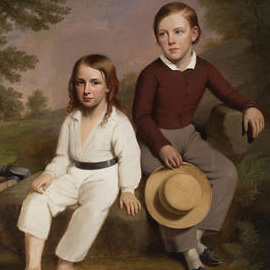2 Anglo- American Portraiture
by Patricia Krupinski
During the 18th and 19th centuries, artists explored the theme of identity as well as influence. Portraiture was an important visual method for advertising wealth, prestige and power, as well as representing the individual. As the middle-class grew, portraits became more and more a sign of wealth, while at the same time becoming increasingly more focused on the individual rather than the office or rank that he or she held.
With colonial independence, portraits not only became a symbol of expendable income, but also as part of what makes a person truly American. It is this identity that American portrait artists were seeking in the 19th century while still drawing inspiration from European artists and tradition. As the country strived to create its own identity, artists used portraits to indicate the ideals of freedom and opportunity, through the placement of symbols within the paintings. This can be seen in the early works of James Sullivan Lincoln (1811 – 1888) who placed his Rhode Island patrons in landscape settings, a reference to the new nation’s identity as a frontier and land of opportunity.
Following the advent of photography in the United States in 1839, portraiture was in decline. Individuals began looking for visages of reproductive exactness and were less interested in sitting for a portrait. Yet, American portraiture continued to shape American identity as many government officials and members of the elite still sought to have their images, and images of their children, painted.
Portraiture in the 19th and 20th Century continued to shape what it meant to be an American, turning from a symbol of America to a symbol of prestige and education, an evolved American identity.
Sources:
Barratt, Carrie Rebora. "American Portrait Miniatures of the Nineteenth Century". In Heilbrunn Timeline of Art History. New York: The Metropolitan Museum of Art, 2000–. http://www.metmuseum.org/toah/hd/mini_2/hd_mini_2.htm (October 2004)
Barratt, Carrie Rebora "Faces of a New Nation: American Portraits of the 18th and Early 19th Centuries." The Metropolitan Museum of Art Bulletin, v. 61, no. 1 (Summer, 2003). http://www.high.org/Press/Press-Releases/2013/December/American-Encounters-Portraiture-Release.aspx

